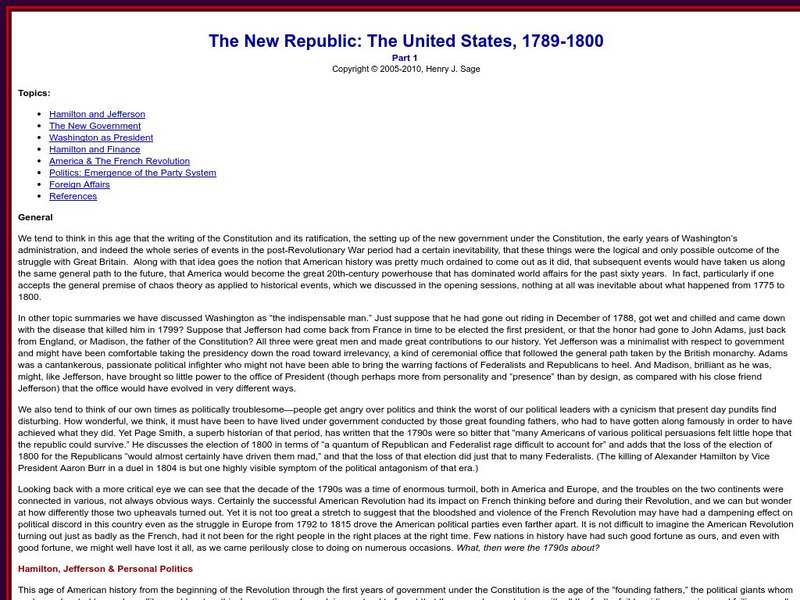Curated OER
How to Celebrate Kwanzaa on Your Campus
An article details everything you need to know about celebrating Kwanzaa at your school. An opening-day ceremony starts the seven-day holiday celebration followed a daily routine that includes a greeting, candle lighting, reciting an...
A&E Television
History.com: Why Isn't Puerto Rico a State?
Located about a thousand miles southeast of Florida, Puerto Rico is a Caribbean archipelago with a complex colonial history and political status. As a territory of the United States, Puerto Rico's 3.2 million residents are U.S. citizens....
US Senate
United States Senate: William Rufus King, 13th Vice President
This long biographical article about William R. King highlights both his character and his service to his country. King was a long-time member of the United States Congress, serving as both a Representative and as a Senator before being...
US Department of State
Us Department of State: u.s. Relations With Iceland
Brief summary of relations between the United States and Iceland which voted with the United States on virtually all major UN, NATO, and environmental issues. This site outlines the relations that exist between Iceland and the U.S. in...
A&E Television
History.com: Greensboro Sit Ins
The Greensboro Sit-In was a critical turning point in Black history and American history, bringing the fight for civil rights to the national stage. Its use of nonviolence inspired the Freedom Riders and others to take up the cause of...
Other
Unc Charlotte: History of Scientific Racism [Pdf]
A scholarly article by Anthropology Professor Jonathan Marks on the history of scientific racism. Published in the Encyclopedia of Race and Racism.
Encyclopedia Britannica
Encyclopedia Britannica: 300 Women Who Changed History: Woman Suffrage
Encyclopedia Britannica site provides a general overview of the history of woman suffrage in the United States and throughout the world.
Siteseen
Siteseen: American Historama: French Revolution and Us History
Comprehensive resource explores the outbreak of the French Revolution (1789-1799) and its effects on United States history.
Henry J. Sage
Sage American History: The New Republic: The United States, 1789 1800
Article discussing the particular events of post-Revolutionary America, 1789-1800, and how they shaped the era of the New Republic. The author covers the first presidency, the emergent party system and foregin affairs.
A&E Television
History.com: Muhammad Ali vs. the United States of America
Fifty years after Muhammad Ali refused military induction during the Vietnam War, a new book, "Sting Like a Bee: Muhammad Ali vs. the United States of America, 1966-1971" by Leigh Montville examines the heavyweight champ's controversial...
A&E Television
History.com: Deb Haaland, Us Interior Secretary, on How She's Influenced by History
In early 2021, Deb Haaland was sworn in as the secretary of the U.S. Department of the Interior, making her the first Native American cabinet secretary in the history of the United States. A tribal member of the Laguna Pueblo, she was...
Khan Academy
Khan Academy: Cultural Heritage at Risk: United States
Over 90% of known Native American archaeological sites have already been destroyed or negatively affected by looters, and this process is ongoing. Further work is critical to prevent any more irreparable damage to our past. This article...
A&E Television
History.com: A Timeline of Us Cuba Relations
The United States and Cuba share a long, complex history -- first as allies and trade partners, and later as bitter ideological enemies. This timeline shows how closely entwined America and Cuba have been over the last two centuries.
Migration Policy Institute
Migration Policy Institute: Immigration in the United States
This country profile examines key legislative events that form the history of the U.S. immigration system, the size and attributes of the immigrant population in the country, the characteristics of legal and illegal immigration streams,...
Khan Academy
Khan Academy: Us History: 1890 1945: Fdr and World War Ii
After leading the United States through nearly a decade of Depression, President Franklin Delano Roosevelt took on the role of Commander-in-Chief when the United States entered the Second World War.
A&E Television
History.com: Key Moments in the Cuban Missile Crisis
The Cuban Missile Crisis was among the scariest events of the Cold War. The 13-day showdown brought the world's two superpowers to the brink of nuclear war. hese are the steps that brought the United States and Soviet Union to the brink...
A&E Television
History.com: The Deadliest Tornado in u.s. History Blindsided the Midwest in 1925
Now known as the Tri-State Tornado, it turned March 18 into a day of gruesome destruction and bizarre survival stories. This tornado hit Missouri, Illinois and Indiana and resulted in nearly 700 deaths.
A&E Television
History.com: The First Thanksgiving Celebration
[Free Registration/Login Required] Thanksgiving Day is a national holiday in the United States. In 1621, the Plymouth colonists and Wampanoag Native Americans shared an autumn harvest feast that is acknowledged today as one of the first...
Khan Academy
Khan Academy: Us History: 1844 1877: Annexing Texas
Quickly following Texan independence, the United States admitted Texas into the republic as a slave state.
A&E Television
History.com: Hispanic History Milestones: Timeline
The American Hispanic/Latinx history is a rich, diverse and long one, with immigrants, refugees and Spanish-speaking or Indigenous people living in the United States since long before the nation was established. America's Hispanic...
Immigration and Ethnic History Society
Iehs: Goodman, Writing u.s. Immigration History on the Other Side of the World
This article is written by a doctoral student of American foreign relations and immigration policy who doing research in Cameroon, Africa. In 1990, just 3000 Cameroonian immigrants resided in the United States. Today the number has...
A&E Television
History.com: Controversial Supreme Court Nominations Through History
Presidents dating back to George Washington have faced opposition to their nominees for the nation's highest court. The justices who sit on the Supreme Court of the United States hold a unique governing power, making their selection...
A&E Television
History.com: Steps Leading to the Fall of Saigon and the Final, Chaotic Airlifts
The conflict in Vietnam ended in 1975 with the largest helicopter evacuation of its kind in history. What led to the fall of Saigon? Although the United States had withdrawn its combat forces from Vietnam after the signing of the Paris...
Gilder Lehrman Institute of American History
Gilder Lehrman Institute: History Now: Every Citizen a Soldier: World War Ii Posters on the Home Front
An article from the quarterly journal, History Now, discusses the importance of posters in World War II in encouraging support in the United States for the war. See examples of posters and read about how they emphasized the role of every...










